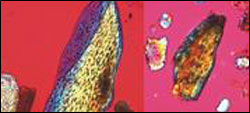Our ancestor’s bones are contaminating animal feeds!

Bone splinters from land animals (left) and from molasses shreds (right) in polarised light in the microscope (200x magnif.). Clearly visible the characteristic "lacunes" <br>Fotos: R. Modi, University of Hohenheim
Results of an experts round table “decomposition behaviour of animal residues in soil” at the Institute of Plant Nutrition and Soil Science, Federal Agricultural Research Centre (FAL), Braunschweig, Germany.
As a result of the BSE-crisis, any feed for livestock must be “free” of anything of animal origin. This EU-decree lasts until 2006 and should prevent “MBM” (Meat Bone Meal) from reaching the feed trough. MBM means the heated, dried and ground remains of animal slaughter waste. In themselves these amount to about a third of total animal slaughter waste, which has to be disposed of, and also includes blood, feathers and other components of animal bodies which are not usually included in feedstuffs. But which, for hygiene reasons, still need to be disposed of. MBM can still be used as a fertiliser, but only MBM of category III, which has to be produced out of non-commercialised or non-marketable material that is classed as “fit for human consumption”.
Checks are made for bone fragments and other animal components, like muscle fibres, hair or feathers in feedstuff samples. These microscopic tests check to identify bones by their characteristic surface patterns, so called “lacuna” (picture 1). If only one tiny identifiable bone splinter is found in a feedstuff, an unauthorised admixture of animal components will be assumed and the whole part will have to be destroyed (“zero tolerance”). This happened on 23rd November 2004 in Ireland, where the authorities blocked the import of 1.645 tons of German feedstuff derived from sugar beet pulp after finding bone fragments. In the immediate aftermath caused by the RASFF (Rapid Alert System for Food and Feed) similar samples were scrutinised in Germany and bone fragments were found “not always but more and more often”.
Against this background, experts met and discussed the origin and detection of bone fragments in field crops at a meeting in the Institute of Plant Nutrition and Soil Science, Federal Agricultural Research Centre (FAL), Braunschweig, Germany.
The remains of animal bodies contain organic (soft tissue, cartilage, horn, hair) and mineral (bones) components. When in the soil, the organic components are almost completely decomposed in 1-2 years (soft tissue), and slightly longer – to 5-8 years for horn and hair, bones remain for far longer periods. Essentially this duration is dependent on the acidity (pH-value) and on the moisture content of the soil. Bones and bone fragments are a normal component of soils, they descend from perished or killed creatures, for example during tilling and harvesting, remains of the predators “meals” and excrements of these predators (for example foxes and birds of prey).
In soils with a pH-value ? 6, there is no appreciable decomposition of bone material in the soil for several hundred years. In lime containing soils bones survive for unlimited periods: Scientists at Goettingen University estimated the total inventory of bones at 9-98 tons per ha in a 0-30cm depth in three quarters of the soils investigated by them. The amounts of MBM accumulating because of the present feeding prohibition represent a considerable waste problem throughout Europe. This makes the use of fertilisers containing his material attractive, because the price of disposal is approx. 200 EUR for burning. The amounts of bones from MBM-fertilising at a typical application of 2 tons of MBM per ha spreads the equivalent amount of bones per square meter of soil as 10 mice carcasses (approx. 15 g).
Bone material can reach the food chain out of the agricultural soils by taking in animals with the crop material or by the external sticking or by soil material grown into tubers (picture 2). The German experts agreed that neither using the microscopic method prescribed by the EU as a standard measure, nor with the latest molecular biological measures (PCR, Polymerase Chain Reaction) is it possible to clearly determine the identity, origin and age of bone fragments in soils and field crops.
As a result the scientists concluded that because of the ubiquitous occurrence of bones in the soils and independent of the use of bones containing fertilisers (for example MBM) with a high probability, bone material can be detected in all field and forage crops resulting from soil adhesion. They further conclude that the Official testing method and especially the zero tolerance of bones in feedstuffs, and the conditions on the use of MBM for fertilising purposes need urgently re-examining.
For further details: Prof. Dr. Dr. Ewald Schnug, Federal Agricultural Research Centre (FAL), Institute for Plant Nutrition and Soil Science, Bundesallee 50, 38116 Braunschweig, E-Mail: pb@fal.de
Media Contact
All latest news from the category: Agricultural and Forestry Science
Newest articles

A ‘language’ for ML models to predict nanopore properties
A large number of 2D materials like graphene can have nanopores – small holes formed by missing atoms through which foreign substances can pass. The properties of these nanopores dictate many…

Clinically validated, wearable ultrasound patch
… for continuous blood pressure monitoring. A team of researchers at the University of California San Diego has developed a new and improved wearable ultrasound patch for continuous and noninvasive…

A new puzzle piece for string theory research
Dr. Ksenia Fedosova from the Cluster of Excellence Mathematics Münster, along with an international research team, has proven a conjecture in string theory that physicists had proposed regarding certain equations….



